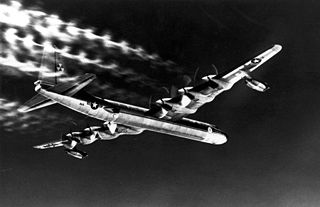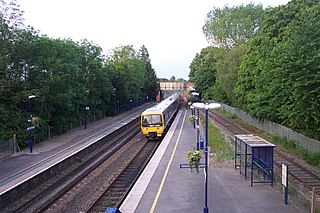Related Research Articles

Sir John Douglas Cockcroft, was a British physicist who shared with Ernest Walton the Nobel Prize in Physics in 1951 for splitting the atomic nucleus, and was instrumental in the development of nuclear power.

British Thomson-Houston (BTH) was a British engineering and heavy industrial company, based at Rugby, Warwickshire, England, and founded as a subsidiary of the General Electric Company (GE) of Schenectady, New York, United States. They were known primarily for their electrical systems and steam turbines.

The Convair X-6 was a proposed experimental aircraft project to develop and evaluate a nuclear-powered jet aircraft. The project was to use a Convair B-36 bomber as a testbed aircraft, and though one NB-36H was modified during the early stages of the project, the program was canceled before the actual X-6 and its nuclear reactor engines were completed. The X-6 was part of a larger series of programs, costing US$7 billion in all, that ran from 1946 through 1961. Because such an aircraft's range would not have been limited by liquid jet fuel, it was theorized that nuclear-powered strategic bombers would be able to stay airborne for weeks at a time.

Aldermaston is a village and civil parish in Berkshire, England. In the 2011 United Kingdom census, the parish had a population of 1015. The village is in the Kennet Valley, and bounds Hampshire to the south. It is roughly equidistant from Newbury, Basingstoke and Reading, and is 46 miles (74 km) west-by-south-west of London.

Aldermaston Court is a country house and private park built in the Victorian era for Daniel Higford Davall Burr with incorporations from a Stuart house. It is south-east of the village nucleus of Aldermaston in the English county of Berkshire. The predecessor manor house became a mansion from the wealth of its land and from assistance to Charles I during the English Civil War under ownership of the Forster baronets of Aldermaston after which the estate has alternated between the names Aldermaston Park and Aldermaston Manor.
JASON was a low-power nuclear research reactor installed by the Ministry of Defence at the Royal Naval College in Greenwich, London, now home to the University of Greenwich, to educate and train military and civilian personnel involved in the naval nuclear submarine propulsion.
PLUTO was a materials testing nuclear reactor housed at the Atomic Energy Research Establishment, a former Royal Air Force airfield at Harwell, Oxfordshire in the United Kingdom.

Aldermaston railway station serves the village of Aldermaston in Berkshire, England. The station is at nearby Aldermaston Wharf and about 2 miles (3 km) north of Aldermaston village. It is 44 miles 63 chains (72.08 km) measured from London Paddington.

The A340 is a major road in the south of England, portions of which are known as the Aldermaston Road, Tadley Hill, Basingstoke Road and Tidmarsh Road.

A.F.C. Aldermaston is a football club based in Aldermaston, Berkshire, England. Affiliated to the Berks & Bucks Football Association, the club are currently members of the Combined Counties League Division One and play at Waterside Park in Thatcham.
The Fast Breeder Test Reactor (FBTR) is a breeder reactor located at Kalpakkam, India. The Indira Gandhi Center for Atomic Research (IGCAR) and Bhabha Atomic Research Centre (BARC) jointly designed, constructed, and operate the reactor.
The Ford Nuclear Reactor was a facility at the University of Michigan in Ann Arbor dedicated to investigating the peaceful uses of nuclear power. It was a part of the Michigan Memorial Phoenix Project, a living memorial created to honor the casualties of World War II. The reactor operated from September 1957 until July 3, 2003. During its operation, the FNR was used to study medicine, cellular biology, chemistry, physics, mineralogy, archeology, anthropology, and nuclear science.

Thomas Edward Allibone, CBE, FRS was an English physicist. His work included important research into particle physics, X-rays, high voltage equipment, and electron microscopes.

Iran's nuclear program is made up of a number of nuclear facilities, including nuclear reactors and various nuclear fuel cycle facilities.
The Aldermaston Brewery was a brewery located near Aldermaston in Berkshire, UK.
The Zoé reactor, or EL-1, was the first French atomic reactor. It was built in 1947 at the Fort de Châtillon in Fontenay-aux-Roses, a suburb of Paris.
Portland House is an office building in Aldermaston, Berkshire, UK. It was designed by Richard Gilbert Scott (1923-2017), the architect son of Sir Giles Gilbert Scott. It was one of the buildings he was most proud of, and in his last years was distressed to learn it was under threat. After the Aldermaston estate was bought by Praxis in 2014, Scott's building was - without proper consultation - awarded a Certificate of Immunity from Listing. In June 2017 the Aldermaston estate was again for sale.
Sceptre was an early fusion power device based on the Z-pinch concept of plasma confinement, built in the UK starting in 1957. They were the ultimate versions of a series of devices tracing their history to the original pinch machines, built at Imperial College London by Cousins and Ware in 1947. When the UK's fusion work was classified in 1950, Ware's team was moved to the Associated Electrical Industries (AEI) labs at Aldermaston. The team worked on the problems associated with using metal tubes with high voltages, in support of the efforts at Harwell. When Harwell's ZETA machine apparently produced fusion, AEI quickly built a smaller machine, Sceptre, to test their results. Sceptre also produced neutrons, apparently confirming the ZETA experiment. It was later found that the neutrons were spurious, and UK work on Z-pinch ended in the early 1960s.

Etcheverry Hall is a building on the UC Berkeley campus that houses the departments of mechanical, industrial, and nuclear engineering of the UC Berkeley College of Engineering. Etcheverry Hall is named after Bernard A. Etcheverry, professor of irrigation and drainage from 1915–51, who later served as chair of the Department of Irrigation and Drainage from 1923–51. Built in 1964, it is located on the north side of Hearst Avenue, across the street from the main campus.
References
- ↑ "Science and Society - Prince Philip opening the 'Merlin' nuclear reactor". 1959. Retrieved 9 December 2009.
- ↑ New Scientist. 23 May 1957. Retrieved 25 September 2011.